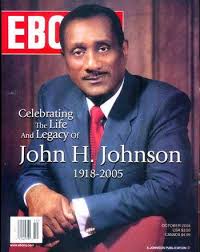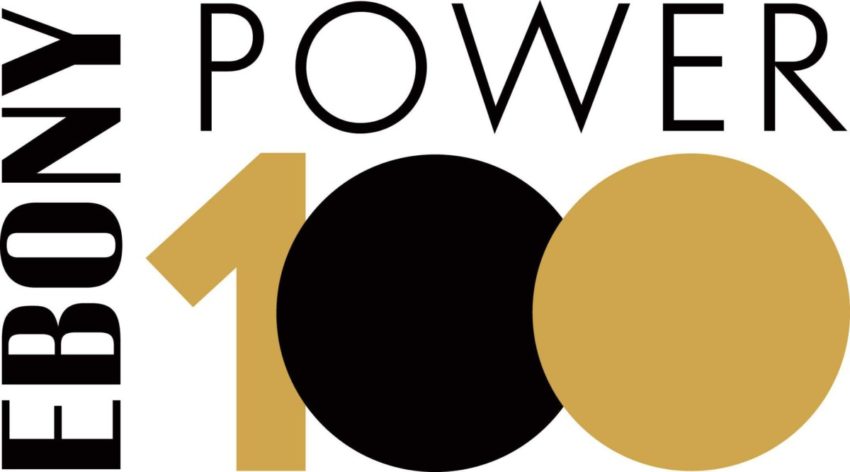
Updated July 6
Board May Refer Its Concerns to Authorities
Allies Confront Own Anti-Black Racism:
Latinos, Asian Americans, Native Americans Speak
Douglass ‘Speaks Up’ on Statue Debate:
Clipping Shows Unhappiness With Lincoln Tribute
Guessing Game On for Next Name of D.C. Team
L.A. Times Owner Answers Black Caucus Demands
Robin Turner to Lead Politico Diversity Efforts
Facebook’s Zuckerberg to Meet Rights Leaders
NABJ Seeks Confidential Info About Essence
Short Takes
Board May Refer Its Concerns to Authorities
The board of directors of the company that owns Ebony magazine — troubled since the venerable publication was bought by a Black-owned Austin, Texas-based company from the founding Johnson Publishing Co. in 2016, has ousted its CEO, the company announced on Sunday.
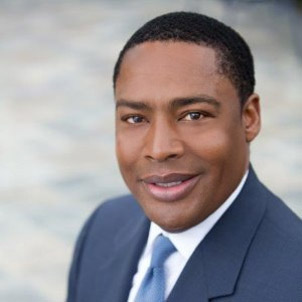 “The board decided to end [the] leadership” of Willard Jackson Jr. (pictured), Jacob Walthour Jr., newly elected board chairman and a black-owned asset manager, told Journal-isms by telephone.
“The board decided to end [the] leadership” of Willard Jackson Jr. (pictured), Jacob Walthour Jr., newly elected board chairman and a black-owned asset manager, told Journal-isms by telephone.
The four-member board of Ebony Media Holdings had contracted with an independent counsel to review transactions “and felt there was enough there there to effect change immediately,” Walthour said. He cited Jackson’s failure to follow procedures, such as securing board approval for certain transactions, and acknowleged, “there is that possibility that the issues are referred to the regular agencies and authorities.
“We weren’t getting the level of transparency that we were accustomed to,” Walthour said, “and it raised a set of red flags.”
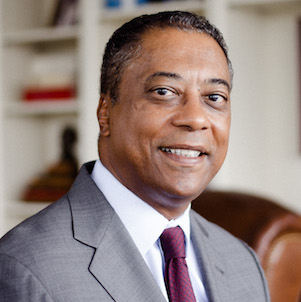 Michael Gibson, (pictured), co-founder and chairman of African-American-owned Clear View Group, which purchased Ebony, left management of the franchise two years ago but remains on the Ebony board, Walthour said.
Michael Gibson, (pictured), co-founder and chairman of African-American-owned Clear View Group, which purchased Ebony, left management of the franchise two years ago but remains on the Ebony board, Walthour said.
Under Gibson and Jackson, Ebony was taken to court by writers who had not been paid; the magazine was difficult to find on newsstands, and in 2017, it laid off nearly all of its masthead — as many as a dozen key members of its editorial team. The Chicago mainstay said it was consolidating editorial operations with sister publication Jet in Los Angeles.
The publication’s operations are now in Houston. Walthour is based in Newark, N.J.
In addition, “Ebony no longer offers a print edition,” spokesperson Jennifer Farmer told Journal-isms.
In its statement, the company said “The board of directors will appoint an interim CEO and operating committee. It will continue to assess all structural, managerial, and financial facets of the organization with an eye toward amplifying the current calls for economic and racial justice and equality. As part of the board’s engagement, they are prioritizing the payment of delinquent compensation to EBONY employees and expect to make announcement soon.”
As for Jet magazine, once a significant part of the company but which ended its print edition in 2014 to go digital, Farmer said, “We are in the early stages of developing a broader JET campaign.”
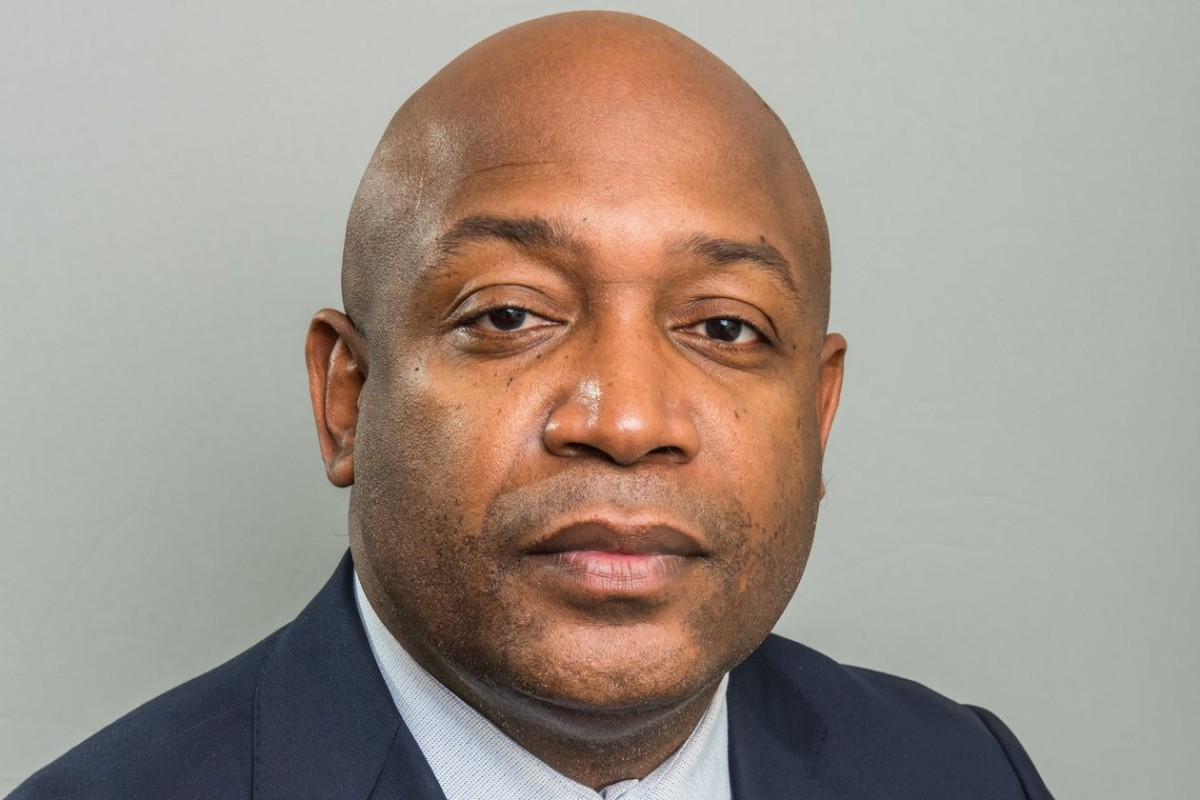 With Jackson out, the remaining board members are Walthour (pictured) of Newark, N.J.-based Blueprint Capital Advisers, John C. Robinson, president and CEO of Atlanta-based Consequent Capital Management, and Gibson, co-founder (with Jackson) of Houston-based CVG Group.
With Jackson out, the remaining board members are Walthour (pictured) of Newark, N.J.-based Blueprint Capital Advisers, John C. Robinson, president and CEO of Atlanta-based Consequent Capital Management, and Gibson, co-founder (with Jackson) of Houston-based CVG Group.
The future of the print publication will rest on an evaluation of the three pillars of the company, Walthour said — the print magazine, the digital operation and the Ebony Power 100, its annual fundraising gala to honor “beautiful black excellence.”
Walthor’s firm was in the news less than two weeks ago when it sued New Jersey for racial bias, saying officials told it that the state’s pension was averse to hiring money-management firms owned by people of color.
“Blueprint Capital Advisors is one of the few U.S. investment firms founded by African-Americans,” Dawn Lim reported June 23 for the Wall Street Journal.
“The Newark firm said in court documents Tuesday that New Jersey’s pension office ‘usurped’ its ideas and hired money-management giant BlackRock Inc. to run Blueprint’s strategy. Blueprint alleges pension staff made efforts to block it from investing state money and turned against the firm after it spoke up about being treated unfairly. Blueprint was eventually hired to run money for New Jersey, but under terms that it describes as ‘punitive.’
“It is rare for an asset manager to sue an investor. . . .”
- N’dea Yancey-Bragg, USA Today: Ebony magazine’s digital staff abruptly laid off without pay as asset auction looms (June 21, 2019, updated June 23)
Allies Confront Own Anti-Black Racism
“We brought together 13 panelists from a diverse cross section of our community . . . to address some of the systemic issues related to race,”” Suzette Hackney wrote June 21 for the Indianapolis Star. (video)
Latinos, Asian Americans, Native Americans Speak
The Black Lives Matter movement, reported by The New York Times Friday to be possibly “the largest movement in U.S. history,” is prompting writers of other races and ethnicities — Latinos, Asian Americans, Native Americans, Arabs and non-Black Muslims — to confront anti=black racism in their own ranks.
“Too often we have brought with us to the United States the anti-Black prejudice that [is] prevalent across Latin America, which was shaped [by] the same structures of slavery and European colonialism as the United States,” Antonio De Loera-Brust wrote May 30 for Latino Rebels.
“From Argentina to Mexico, Latin American societies are deeply racist against people of African origin. These very same societies have celebrated and worshipped whiteness for centuries at the expense of our fellow Black Latin Americans. If we can’t confront that reality, how can we begin to confront what is in front of us right here in the United States?”
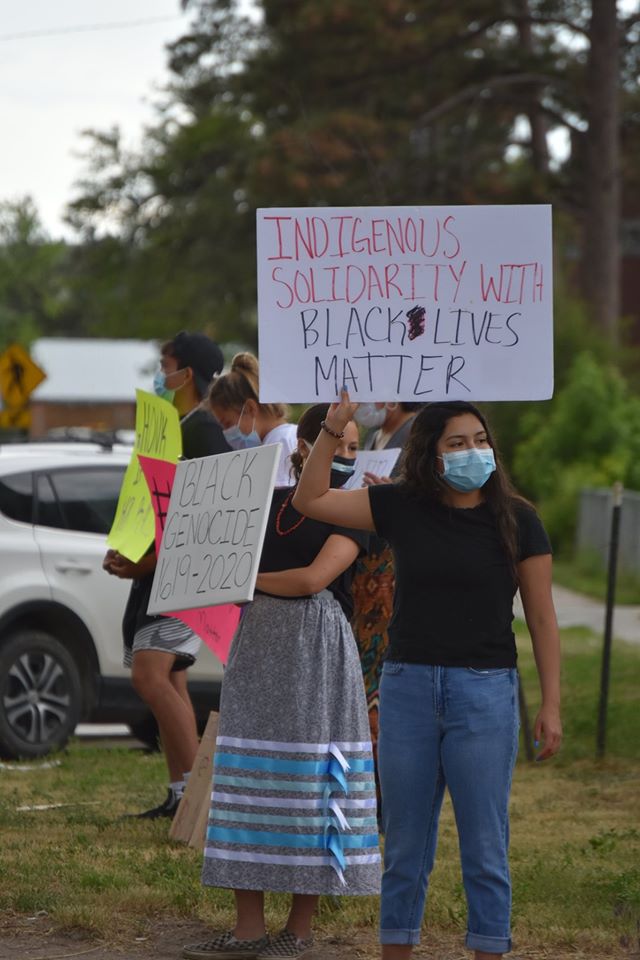 Tim Giago, an Oglala Lakota and a founder of the Native American Journalists Association, wrote Monday for indianz.com, “If Native Americans are going to seriously discuss racism I think we should be taking a close look at ourselves.” (Pictured: Oglala Sioux tribe)
Tim Giago, an Oglala Lakota and a founder of the Native American Journalists Association, wrote Monday for indianz.com, “If Native Americans are going to seriously discuss racism I think we should be taking a close look at ourselves.” (Pictured: Oglala Sioux tribe)
None of the non-Black groups has a monopoly on racism, and Blacks can be bigoted toward other groups.
Still, Giago recounted, “Many years ago a group of Lakota girls were a short way from their village swimming when a troop of U. S. soldiers rode up. There [were] no such things as swimming suits back then so the girls were swimming nude. The soldiers dragged them from the water and raped them. Some of the girls got pregnant and gave birth to mixed blood children.
“When the black Buffalo Soldiers patrolled the Dakotas along with their white cavalry companions they would sometimes fall in love with Lakota women, marry them and have children. Their children were called Hasapa’s by the Lakota. The children of mixed white blood were called Iyeska. Actually the word Iyeska was first used as a name for the translators who were usually half French. . . .
“Every one of these children experienced racial discrimination from members of their own tribe. One who rose to be a prominent attorney was often dismissed as a ‘Mexican’ even though on his mother’s side of his family, he carried the blood of Lakota chiefs. . . .”
Writing for HuffPost on Friday, Rowaida Abdelaziz referenced African American George Floyd’s death at the hands of Minneapolis police and reminded readers, “Black Muslims were among the first Muslims in the U.S., particularly those who were captured and enslaved in the 17th century.
“But they are often ignored in mainstream conversations about Islam. Now, the protests that have rocked the world in the weeks since Floyd’s death are also forcing non-Black, predominantly Arab and South Asian Muslims to evaluate their role in systemic injustice. . . .”
Abdelaziz also wrote, “The conversation became more real for members of the Arab and non-Black Muslim communities in the U.S. when they learned that it was an employee at Cup Foods — a convenience store owned by a Palestinian American Muslim man — who called Minneapolis police on Floyd over a suspected counterfeit $20 bill.”
Ahmad Jitan, a community organizer for the Inner-City Muslim Action Network, a community organization and clinic with facilities on the South Side of Chicago, “has partnered with MuslimARC to create ‘Corner Store Witness,’ an online curriculum for non-Black Muslim business owners about how to navigate their relationship with Black customers in an equitable and moral way. . . .”
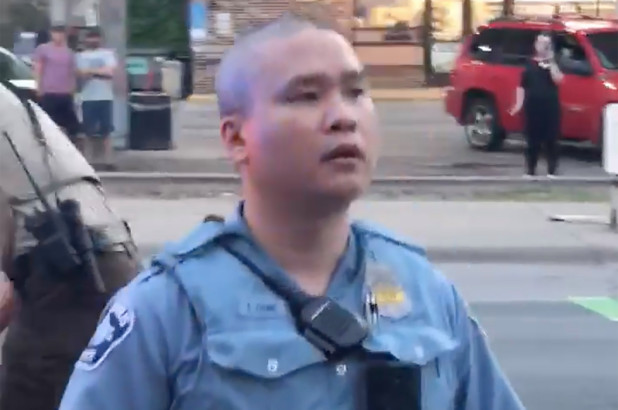 Shortly after Floyd’s death, Kimmy Yam wrote June 1, updated June 4, for NBC Asian America, “The image of then-Minneapolis police Officer Tou Thao (pictured), a Hmong American, standing with his back turned as a white officer knelt on George Floyd’s neck has ignited a discussion about how to approach the topic of anti-blackness in the Asian American community. . . . “
Shortly after Floyd’s death, Kimmy Yam wrote June 1, updated June 4, for NBC Asian America, “The image of then-Minneapolis police Officer Tou Thao (pictured), a Hmong American, standing with his back turned as a white officer knelt on George Floyd’s neck has ignited a discussion about how to approach the topic of anti-blackness in the Asian American community. . . . “
Yam also wrote, “Several experts expressed that this is a pivotal moment for Asian Americans to tackle the subject of anti-blackness in a productive way, beginning with unpacking the biases in their own communities by first confronting the historical context behind it. . . . “
Sewell Chan, editorial page editor of the Los Angeles Times, sought to emphasize the ties between Asian Americans and African Americans in a June 22 essay.
“Anti-Black racism and anti-Asian racism have often gone hand in hand, serving similar functions of distracting Americans from the common values and interests that should unite them.” President Trump’s repeated descriptions of COVID-19 as the “kung flu” “is but a taste of the kind of verbal abuse that Black Americans routinely face in our society.”
To be sure, a wide spectrum of Americans, including the journalists of color organizations, is expressing outrage at the racism brought to the fore by the Floyd killing. Among the latest is Unify:(emphasis added): Journalists for Diversity, a New England coalition formed in 2017 and modeled after Unity: Journalists for Diversity, which was soon to dissolve.
“Unify” includes the New England chapters of the National Association of Black Journalists, the Asian American Journalists Association, the National Association of Hispanic Journalists, and the NLGJA: The Association of LGBTQ Journalists.
“Those of us who are non-Black Latinx, AAPI, and LGBTQ journalists support our Black colleagues, our Black loved ones and neighbors, and the Black and biracial members of our own communities demanding an end to police violence and systemic racism,” they declared on June 26.
“The Black communities we cover are in pain. We pledge to listen for insight and guidance as we support change driven by Black voices, ideas, and priorities. We pledge to foster frank conversations within and among our communities about the anti-Black racism that exists in every community. . . .”
- Rekha Basu, Des Moines Register: Why rally for black lives in white, rural Grundy Center? ‘White lives aren’t daily in danger’ (June 12, updated June 20)
- Stephen Battaglio, Los Angeles Times: As the nation struggles with racism, CBS News veteran Michelle Miller gets personal
- Rich Benjamin, the Intercept: I Am a Book Critic. Here’s What Is Wrong With “Black Lists” — and What Is Good.
- Douglas D. Ford, Atlanta Journal-Constitution: Quiet white Christians don’t know what to say now (June 27)
- Emil Guillermo, Asian American Legal Defense and Education Fund: Asian Americans speak out on “kung flu” fallout; California + other states shut down again; GOP distancing from Trump?
- Daniel Hernandez, Los Angeles Times: Police violence against journalists recalls slaying of Ruben Salazar (June 20)
- Roy S. Johnson, al.com: White people, here’s your racial re-education reading list
- Erin Aubry Kaplan, Los Angeles Times: White tribalism is under assault — from white people. That’s an amazing development (June 11)
- Frank Shyong, Los Angeles Times: In the midst of a racial reckoning, I’m wondering: What does whiteness mean? (June 15)
- Olúfẹ́mi Táíwò, Washington Post: The best way to respond to our history of racism? A Truth and Reconciliation Commission.
- Adrian Walker, Boston Globe: As social justice movement grows, Chinatown takes stock (June 14)
- Rod Watson, Buffalo News: Students save ‘race’ class at time it’s needed most
Douglass ‘Speaks Up’ on Statue Debate
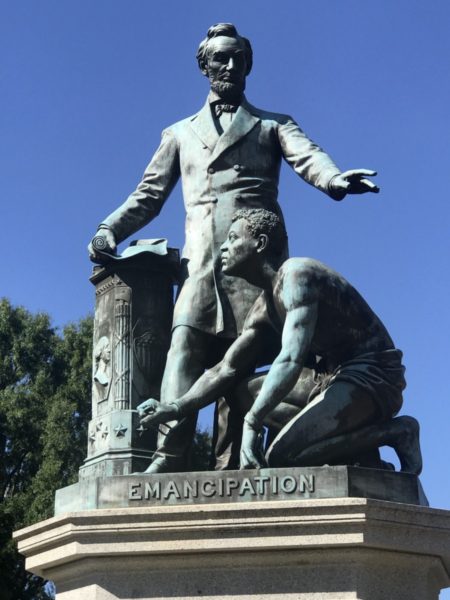
Clipping Shows Unhappiness With Lincoln Tribute
A newspaper clipping has emerged as a key bit of evidence in a controversy over an 1876 statue depicting Abraham Lincoln, holding a copy of the Emancipation Proclamation, standing over a formerly enslaved man, now unshackled but in a loincloth, looking up at the “Great Emancipator.”
The clipping shows that Frederick Douglass, who spoke at the unveiling of the Washington statue, originally conceived of and funded by freed Black people, in fact did not like it.
[Update: A statue of Douglass in Rochester, N.Y., was toppled from its base Sunday and left near the Genesee River gorge. The damage to the statue was said to be too significant for it to be repaired, but another is to take its place, Gary Craig and Ryan Miller reported for the Rochester Democrat and Chronicle.]
As James Holmann reported with Mariana Alfaro Wednesday in the Washington Post, “seven score and four years later, some people want to get rid of the statue. The activists who have been gathering almost every night in Washington’s Lincoln Park, a few blocks from the Capitol, for more than a week say the depiction diminishes the agency of black people in securing their own liberation. Some even say it promotes white supremacy. A few local leaders have called for the monument to go into a museum. . . .”
A District of Columbia Council candidate, Marcus Goodwin, has gathered more than 7,000 signatures on a petition to either remove or alter the Lincoln statue. Eleanor Holmes Norton, D.C.’s nonvoting representative in Congress, has said she would introduce legislation to move the statue to a museum.
Boston’s art commission voted unanimously on Tuesday night to remove an exact replica of the statue that was installed in a park just off Boston Common in 1879.
The Fourth of July weekend is already a notable one for Douglass, abolitionist and publisher of the storied newspaper The North Star. Douglass’ speech “What to the Slave is the Fourth of July,” delivered July 5, 1852, is widely referenced. The Philadelphia Inquirer, for instance, ran the text on its editorial page Saturday and on NPR, Douglass’ descendants read excerpts from it.
The discovery of the clipping is testimony to Douglass’ enduring relevance and to the value of newspapers as keepers of “the first rough draft of history.”
Defenders of the statue note that Black people of the time celebrated it. Jonathan White, who teaches at Christopher Newport University, wrote June 26 in The Hill, “The National Lincoln Monument Association counted among the leaders some of the most prominent African Americans of the era. They included Frederick Douglass, Henry Highland Garnet, Robert Smalls, Daniel Payne, and [Martin R.] Delany. To be sure, a white organization had eventually taken on the organizing process and design selection, but the statue was something that the Black community of Washington took great pride in.
“The first donation for the statue came from a former slave in Ohio named Charlotte Scott. She handed five dollars to her former enslaver and said, ‘The colored people have lost their best friend on earth. Lincoln was our best friend and I will give five dollars of my wages toward erecting a new monument to his memory.’ Word of her remarkable gesture made it into the newspapers, and soon others made similar contributions.
“When the monument was finally dedicated in 1876, African American civic organization members paraded through the streets of Washington for two hours before it was unveiled in Lincoln Park. . . .”
In the Wall Street Journal on Saturday, Ted Mann described the detective work in documenting how Douglass really felt.
On “the last Friday evening in June, sitting on the couch with his wife watching ‘Gilmore Girls,’ Mr. White was texting back and forth” with fellow historian Scott Sandage of Carnegie Mellon University, “pondering the alleged distaste for the statue by Douglass, who had dedicated it with a famous address in 1876. (payroll)
“The account of Douglass criticizing the statue at its unveiling came from a 1916 book that included the recollection of activist John W. Cromwell, who was in attendance.
“”Mr. White pointed out the account was secondhand from three decades later, and could be apocryphal. Mr. Sandage had thought Cromwell’s account had been corroborated and cited it in his own work in the 1990s. He went searching for a corroborating account.
“Mr. Sandage said he didn’t at first realize the importance of his discovery, but alerted Mr. White and texted an image of the letter to David Blight, a Douglass biographer and history professor at Yale University.
“Mr. Blight was ‘practically giddy,’ Mr. Sandage said. . . .”
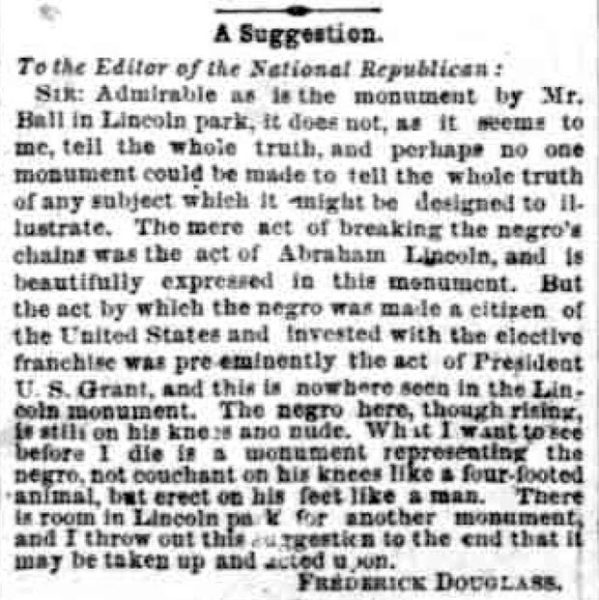
Mann also wrote, “Mr. Goodwin has said that concerns about the statue could be addressed by adding more Black figures to the statue that are in standing positions, including contemporaries of Lincoln like Douglass. It is a compromise that the newly discovered Douglass letter seems to anticipate.
“Still others believe the existing monument should be moved, including Kirk Savage of the University of Pittsburgh, whose work includes ; ‘Standing Soldiers, Kneeling Slaves,’ a history of monuments erected after the Civil War.
“ ‘It is a distorting image,’ Mr. Savage said. ‘It’s a white savior narrative that puts Lincoln in the position of a kind of saint, working a miracle cure on the enslaved population.’
“If new additions to the memorial are done right, Mr. Sandage said, ‘the original statue would become an artifact and the new groupings around it would become the focus.’
“Mr. White said that ‘people of good will are on both sides’ of the issue. ‘If people had listened to [Douglass] it might have resolved it 144 years ago,’ he said. . . .”
[DeNeen L. Brown wrote July 6 in The Washington Post that the real-life model for the statue, Archer Alexander, was an active agent in his own freedom and not passive as depicted.
[Brown quoted historian Arica L. Coleman, author of “That the Blood Stay Pure: African Americans, Native Americans, and the Predicament of Race and Identity in Virginia.”
[“The monument is historically inaccurate,” Coleman said. “It gives the impression that we were just sitting around waiting for Lincoln to free us. That is not true. From the beginning of the war, we were running away. A lot of us were going into the Union lines seeking freedom. Black people were like, ‘I’m not sitting here waiting to be freed.’ So a lot of them just took off and they ran into the Union lines.”
[Brown added, “Decades later, the family of boxing great Muhammad Ali discovered through family DNA research that Ali was the great-great-great-grandson of Alexander. . . . “]
- Andrew Bacevich, Boston Globe: Firing BU’s mascot won’t advance racial equality
- David W. Blight, Washington Post: Yes, the Freedmen’s Memorial uses racist imagery. But don’t tear it down. (June 25)
- Charles M. Blow, New York Times: Yes, Even George Washington (June 28)
- Editorial, Kansas City Star: Take down Andrew Jackson statues. But don’t let vandals decide which KC monuments must go
- Jon Gabriel, Arizona Republic: It’s easier to topple a Confederate statue than do the hard work of rooting out racism
- Emil Guillermo, Asian American Legal Defense and Education Fund: George Floyd, racist monuments, and one in Minneapolis called “The Hiker”
- Earl Ofari Hutchinson, Hutchinson Report: Be Careful What Monuments You Go After
- Liz Vizza, Boston Globe: Monuments and their meanings: Whose story do they represent?
- Isabel Wilkerson, New York Times Magazine: America’s Enduring Caste System
I nominate @petemrogers rebrand of the Washington Redtails in honor of the Tuskegee airmen. Would be brilliant and can keep the same colors. https://t.co/fjmgzS9O6D pic.twitter.com/kv9bGkKXWm
— A.J. (@AJM0013) July 2, 2020
Guessing Game On for Next Name of D.C. Team
“What will the new name of the Washington NFL team be after ‘Redskins’ is disposed of?” Chris Russell asked Saturday for Sports Illustrated..’ . . .”
“The obvious answer is we don’t know but sources told RedskinsReport.com that Dan Snyder would like to pay homage to the past.
‘”Another source backed that desire up and also added that paying homage to the past and not completely burying the controversial history of the franchise is important to Snyder, who once famously said “we’ll never change the name. It’s that simple. NEVER — you can use caps.’
” ‘Dan realizes that the Redskins name is detrimental to business,’ one source said.
“The same source added that it was a very good ‘bet’ that the name would change soon. . . .”
- Kevin Blackistone with Amna Nawaz, “PBS NewsHour”: A tipping point for Washington, D.C., football team’s name
- Jerry Brewer, Washington Post: Daniel Snyder no longer has a choice, and he knows it.
- Paul Hoynes, cleveland.com: How long will the Cleveland Indians be called the Cleveland Indians?
- Clarence Page, Chicago Tribune: What my collection of racist memorabilia teaches
- Kolby KickingWoman, Indian Country Today: Washington NFL team name is the ‘equivalent of the Confederate flag’
- Mary Emily O’Hara, adweek.com: We Asked These 10 Brands Why They Still Sell Washington Redskins Merchandise
- Mary Emily O’Hara, adweek.com: Investors Ask Nike, FedEx and PepsiCo to End Relationships With the Washington Redskins
- Stephen Whyno, Associated Press: Redskins to have ‘thorough review’ of name amid race debate
- Tom Withers, Associated Press: Cleveland Indians look into changing name amid pressure
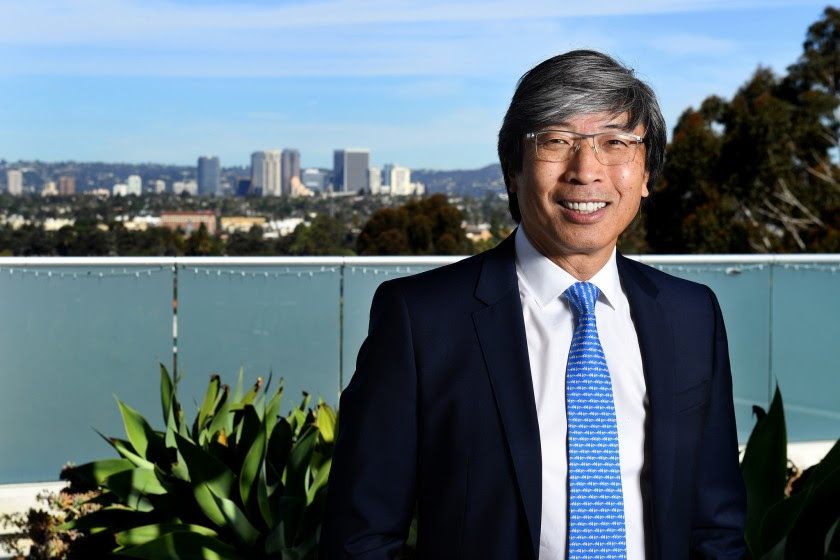
L.A. Times Owner Answers Black Caucus Demands
Dr. Patrick Soon-Shiong, owner of the Los Angeles Times, responded Thursday to demands from the Black Caucus of the L.A.Times Guild by pledging to hire “more Black journalists over the next thirty-six months to better reflect the diversity of Southern California” and to begin “reshaping our coverage to address unconscious bias, evident in the frequent headline use of terms such as ‘looting.’ . . .”
Soon-Shiong, who bought the newspaper two years ago, wrote the group, “At the Los Angeles Times, we acknowledge a need for change. Michele and I commit to communicate and fulfill our personal and institutional goals to you and our staff to be the beacon of change.
“We will accelerate processes that began our first day as the paper’s first non-white owners: diversifying the organization to represent Los Angeles, especially by providing more coverage of Black, Latino and other under-represented communities in our English and Spanish publications. We will enhance transparency and the effort to ‘shape-shift’ the LA Times. . . .”
The Black Caucus asserted on June 23, “We are in a crisis and it is not new. Those of us who have been here since the tumult of 1992 say history is repeating itself. We don’t have enough Black journalists — or, more broadly, journalists of color — to cover our overwhelmingly diverse city, state and nation with appropriate insight and sensitivity.
“And most of us who do work here are often ignored, marginalized, under-valued and left to drift along career paths that leave little opportunity for advancement. Meanwhile, we’re hearing the same empty promises and seeing the same foot-dragging from management.”
While Soon-Shiong did not meet all of the caucus’ demands, he did commit to:
- “Hiring more Black journalists over the next thirty-six months to better reflect the diversity of Southern California. The management team will share more detailed road maps containing data, deadlines, and key performance indicators.
- “Enhancing and promoting our HR career mapping resources for Black employees throughout the organization to advance their careers. A Diversity and Inclusion Committee is collectively addressing programs and training needs.
- “Reviewing compensation on an annual basis to ensure all employees are paid equitably. Pay disparities on the basis of race are unacceptable.
- Evaluating the 2018 and 2019 Metpro program as well as engaging fellows’ help to re-imagine it.
[Meg James and Daniel Hernandez reported June 24 for the newspaper, “One of the flashpoints in the discussion has been Metpro, originally known as the Minority Editorial Training Program, which the paper has relied on since 1984 to develop a pipeline of working journalists, including copy editors and photographers, from underrepresented groups.
[“But many young staffers complained about how Metpro had been mismanaged and abused. Staffers said a program that has produced world-class journalists, including Pulitzer Prize-winners and high-ranking editors, had turned into a ‘Survivor’-like competitive culture where young journalists were pitted against one another.”]
- “Reshaping our coverage to address unconscious bias, evident in the frequent headline use of terms such as ‘looting,’ which we must understand within a narrative that associates criminality with Black lives. In addition to unconscious bias in protest coverage, the Editorial Board will publish a piece that examines our past, from the reporting of ‘Zoot Suit’ riots to the coverage of redlining, or the use of the active voice for protestors versus passive voice for police.
- “Meeting the Black Caucus as well as other Black staff members and people of color to listen and understand. Although meetings have been requested with [Executive Editor] Norm [Pearlstine] and the management team, we would like to invite additional discussions as a priority for us over the upcoming weeks. . . .”
In their June 24 report, James and Hernandez wrote, “Two years after the Los Angeles Times reverted to local ownership, one of the country’s largest metropolitan daily newspapers is facing a painful internal reckoning over glaring deficiencies and missteps regarding race and representation in its pages and its staff. . . .”
Robin Turner to Lead Politico Diversity Efforts
2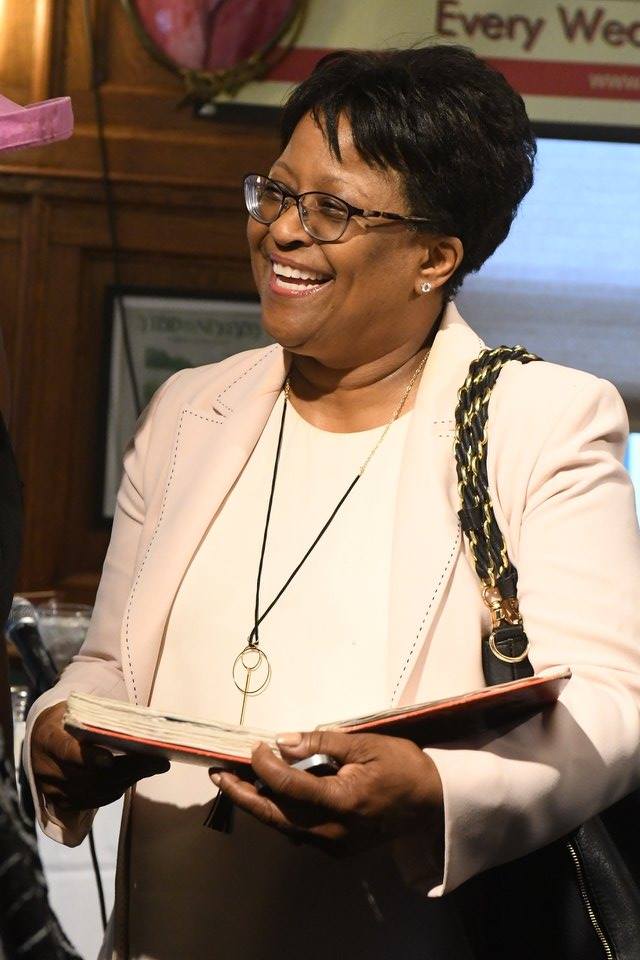 “Today we’re delighted to unveil a new position charged specifically with advancing diversity and inclusion in the newsroom, including the recruitment and mentorship of journalists of color,” Politico Editor in Chief Matt Kaminski; Editor Carrie Budoff Brown, and Joseph J. Schatz, managing editor, platforms and operations, announced to the staff on June 25.
“Today we’re delighted to unveil a new position charged specifically with advancing diversity and inclusion in the newsroom, including the recruitment and mentorship of journalists of color,” Politico Editor in Chief Matt Kaminski; Editor Carrie Budoff Brown, and Joseph J. Schatz, managing editor, platforms and operations, announced to the staff on June 25.
“And equally thrilled to appoint Robin Turner (pictured, by Jason Miccolo Johnson) to it as POLITICO’s Director of Editorial Diversity Initiatives, effective immediately.”
They also wrote, “We’ve established smarter hiring policies to ensure better representation across the publication, invested in programs to build stronger pipelines of journalists and engaged more deeply with journalism diversity groups. These efforts are paying off in real ways: People of color now comprise a quarter of POLITICO’s staff, up from 14 percent less than four years ago. . . .
“Robin’s mandate is ambitious, and she’ll initially focus on several priority projects.
- “Working closely with editors as well as our partners in Human Resources, Robin will take full part in discussions on hiring and recruitment and work to identify promising candidates from diverse backgrounds for editing and reporting openings across the publication — including new posts that we expect to fill as soon as possible to help us strengthen our coverage of this historic moment. . . .
- “Create and direct an expanded training program for journalists of color early in their careers . . . .
- “Spearhead and oversee the evolution of the POLITICO Journalism Institute, our educational initiative dedicated to diversifying Washington-area newsrooms that’s now in its seventh year. Carried out in partnership with American University and The Robert C. Maynard Institute for Journalism Education, the PJI program draws on journalists across our newsroom to offer university students and recent graduates intensive, hands-on training. . . .”
The memo said of Turner, “An Ohio native, Robin joined the POLITICO copy desk in the early days, in 2010. She has spent decades at national and international publications, including 14 years at USA Today and nine years with Dow Jones and The Wall Street Journal. For most of her time with POLITICO, she has worked tirelessly to build PJI from an idea to a program that sets the industry standard. . . .”
The Washington Post last month advertised for a managing editor for diversity and inclusion as part of its diversity initiative.
- Selymar Colón, Nieman Reports: Reimagining Latinx Representation in American Journalism
- Tony Cox, Los Angeles Times: Who tells the story matters. And that’s why you need Black journalists at every level in newsrooms
- Joe Davidson, International Press Institute: Black journalists are making their voices heard. Will newsrooms listen? (includes comments from Journal-isms)
- Neal Justin, Star Tribune, Minneapolis: Floyd story got personal for Black journalists
- Wesley Lowery, New York Times: A Reckoning Over Objectivity, Led by Black Journalists (June 23)
- Besha Rodell, New York Times: Australia Faces its Own Reckoning Over Diversity in Media
- Nitasha Tiku, Washington Post: Black women say Pinterest created a den of discrimination — despite its image as the nicest company in tech
- Laura Wagner and Maxwell Strachan, Vice News: What Went Wrong at the Los Angeles Times
Facebook’s Zuckerberg to Meet Rights Leaders
“For years, Facebook Inc. brushed off complaints from civil rights groups that it didn’t do enough to combat racism, discrimination and voter suppression flourishing on its site,” Naomi Nix reported Sunday for Bloomberg. “Now, pressure from a boycott by major advertisers is forcing the social media giant to address their concerns.
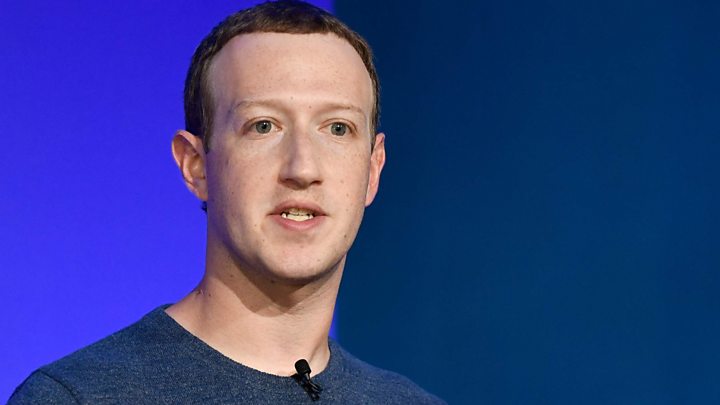 “Facebook Inc. Chief Executive Officer Mark Zuckerberg (pictured) has agreed to meet on Tuesday with leaders of the National Association for the Advancement of Colored People, the Anti-Defamation League and Color of Change to discuss their requests. Facebook is increasingly playing defense against a growing group of civil rights organizations, employees and companies demanding that the technology giant do more to fight injustice on its platform. . . .”
“Facebook Inc. Chief Executive Officer Mark Zuckerberg (pictured) has agreed to meet on Tuesday with leaders of the National Association for the Advancement of Colored People, the Anti-Defamation League and Color of Change to discuss their requests. Facebook is increasingly playing defense against a growing group of civil rights organizations, employees and companies demanding that the technology giant do more to fight injustice on its platform. . . .”
“Concerns have included how the platform has promoted discriminatory advertising, allowed foreign adversaries to try to suppress the Black vote, and let white supremacy groups organize rallies. . . .’
“Civil rights advocates had been contacting Facebook as early as 2017 about issues such as hate speech and election interference, but intensified their outreach following reports that Russian operatives had exploited Facebook and other platforms to suppress Black voting, stir social unrest and help Trump win the 2016 election. . . .”
Sahil Patel added Thursday for the Wall Street Journal, “Among the top requests from the groups will be for Facebook to hire an executive with civil rights expertise for a post in the social-media giant’s C-suite. . . . [paywall]
“Thursday, a Black Facebook employee and two job candidates filed a complaint with the Equal Employment Opportunity Commission saying Facebook is biased against Black employees and makes it more difficult for them to get hired and promoted. Among other issues, the employee said he heard the N-word said at work. . . .
“Other steps requested of Facebook by the boycott organizers include the creation of an internal system to automatically flag hateful content in private groups for human review, and the finding and removing of public and private groups focused on white supremacy, violent conspiracies, vaccine misinformation and other objectionable content. . . .”
- Barbara Ortutay, Associated Press: Black worker files discrimination complaint against Facebook
- Julie Posetti, CNN: Journalists like Maria Ressa face death threats and jail for doing their jobs. Facebook must take its share of the blame
- Kevin Roose, New York Times: Social Media Giants Support Racial Justice. Their Products Undermine It. (June 19, updated June 22)
- Craig Silverman, BuzzFeed News: Black Lives Matter Activists Say They’re Being Silenced By Facebook (June 19)
- Jacob Silverman, Columbia Journalism Review: Spies, Lies, and Stonewalling: What It’s Like to Report on Facebook

NABJ Seeks Confidential Info About Essence
The National Association of Black Journalists encouraged its members and others Friday to email the organization to share confidential information about mistreatment of employees at Essence magazine. The email address is nabjalerts@gmail.com.
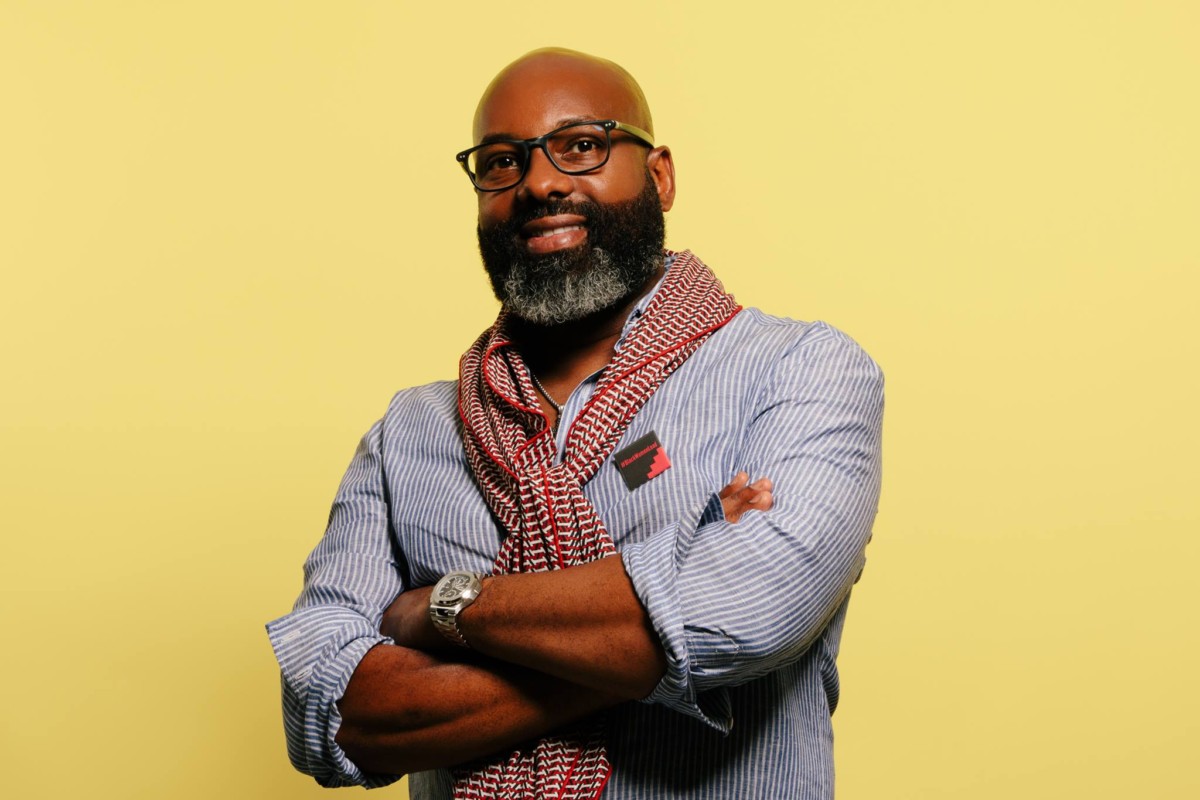 The statement followed publication Monday of an anonymous letter on medium.com by purported current and former Essence employees that said, “for the Black women who [make up] over 80% of the company’s workforce, they are systematically suppressed by pay inequity, sexual harassment, corporate bullying, intimidation, colorism and classism. . . .”
The statement followed publication Monday of an anonymous letter on medium.com by purported current and former Essence employees that said, “for the Black women who [make up] over 80% of the company’s workforce, they are systematically suppressed by pay inequity, sexual harassment, corporate bullying, intimidation, colorism and classism. . . .”
Essence Communications responded at first with a statement that “the accusations are false and we fully deny them.” Then, on Tuesday, it announced that it is hiring “law firms and other independent external experts” to review the accusations and named a new interim CEO to replace owner Richelieu Dennis (pictured) in that role.
However, the company took issue Thursday with language in some reports that said Dennis had “resigned” as interim CEO.
“There was no interim CEO at ESSENCE Communications, Inc. (ECI), following the departure of Michelle Ebanks on March 31 until Richelieu Dennis appointed Caroline Wanga to this position on July 1. As owner, Dennis helped to lead the team along with the ECI senior leadership team, but never took on the roles or responsibilities of CEO. So he never stepped down from, resigned from or was replaced in any role.”
In a statement posted on Twitter Thursday, the anonymous group, #BlackFemaleAnonymous, claimed success, though it said it was awaiting further moves.
“As of Sunday, June 28, the day our testimonial The Truth About Essence went live, there is a community-driven accountability watch on Essence, its ownership and advertising partners. As of business day 4, existing staff are released from the toxic management style of Richelieu Dennis, Michelle Ebanks, Joy Collins Profet and MoAna Luu,” company executives.
<
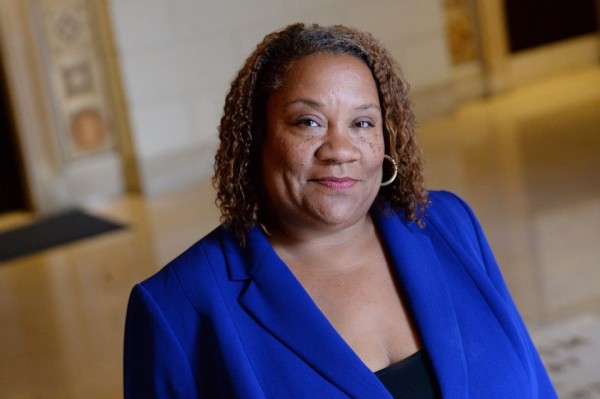
Dana Canedy heads to Simon & Schuster (Credit: Pulitizer Prizes)
Short Takes
- Dana Canedy, who has been the administrator of the Pulitzer Prizes since 2017, has been named executive v-p and publisher of the S&S imprint, effective July 27,” Jim Milliot reported Juy 6 for Publishers Weekly. She was formerly at the New York Times. Under Canedy, the Pulitzers became more inclusive, with, as one example, hip-hop artist Kendrick Lamar winning in the music category in 2018 over classical music and jazz artists.
- The Society of Professional Journalists is recognizing Marty Baron, executive editor of the Washington Post; Nikole Hannah-Jones, New York Times Magazine writer who won a Pulitzer Prize for an essay on “The 1619 Project”; Jorge Ramos, anchor for ”Noticiero Univision” since 1986; Les Zaitz, editor and publisher of the weekly Malheur Enterprise newspaper, based in Vale, Ore.; and, posthumously, Gwen Ifill, co-anchor and managing editor of “PBS NewsHour;” as Fellows of the Society, the highest professional honor awarded by SPJ, the society announced Thursday.
- The John S. Knight Journalism Fellowship is now remote and topical,” the Stanford University-based program announced Wednesday. “Applications, due July 22, should focus on ‘practical solutions that address the flaws in how our industry serves communities of color in the United States. The novel coronavirus has exposed systemic failings in many of our institutions, including journalism. We are creating a remote fellowship model specific for the upcoming 2020-2021 cycle to address the urgent needs of our times. Fellows will craft and develop practical solutions that address the flaws in how our industry serves communities of color in the United States.”
- Newsrooms are reflecting “upon their relationship with law enforcement — especially reporters’ reliance on official police accounts as they construct breaking news stories about a violent incident or arrest,” Paul Farhi and Elahe Izadi reported Tuesday for The Washington Post. “In several of these cases, cellphone video of the incident offered a dramatic contradiction of the first police accounts. . . .”
- In North Carolina, ““the editor and publisher of the Roxboro Courier-Times resigned Tuesday, a day after apologizing for a racist editorial cartoon the paper published last week,” Steve Wiseman reported June 16 for the News & Observer in Raleigh. “The Person County newspaper published a story on its website Tuesday that said Johnny Whitfield had resigned, effective immediately. He confirmed his resignation in a text message to The News & Observer. . . . On Monday, Whitfield apologized in a column, writing ‘my judgment fell short’ when a syndicated cartoon depicting a Black man, wearing a face mask while stealing a white woman’s purse, was printed on June 11. In the cartoon, when the woman calls for help, the man is saying ‘Good luck with that lady. We defunded the police.’ . . .”
- “A group of transgender journalists has launched a global organization to address issues around trans media coverage and promote newsroom diversity,“ Zlati Meyer reported Wednesday for Fast Company. “The Trans Journalists Association, which launched yesterday, has since grown to an estimated 100 members . . . TJA has been in the works for about a year; it began as a Facebook group and then migrated to Slack. . . .”
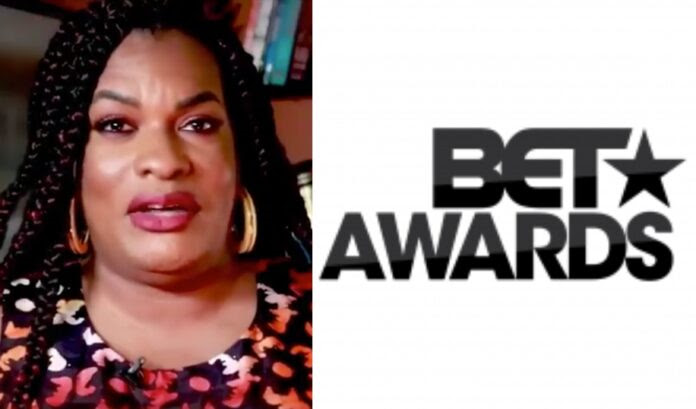 “An ad I made about the need to protect the lives of Black trans women was set to run” during the BET Awards on June 28, Imara Jones (pictured) wrote Thursday for The Grio. “Yet by the end of the three-hour program, I sat in shock because my message had never crossed the screen. Slowly I became enraged at the realization that all fingers for how this came to be pointed to BET, a network with a track record of transphobia.” A BET spokesperson messaged Journal-isms Friday, “We respect Imara Jones’ concerns, but want to be absolutely clear that BET did not select the McDonald’s commercial spots that aired during the BET Awards. BET emphatically and unambiguously stands in support of all Black people, including members of the LGBTQ+ community. We care deeply about reflecting the full range of the Black experience, and we are committed to proactively amplifying LGBTQ+ voices and stories.”
“An ad I made about the need to protect the lives of Black trans women was set to run” during the BET Awards on June 28, Imara Jones (pictured) wrote Thursday for The Grio. “Yet by the end of the three-hour program, I sat in shock because my message had never crossed the screen. Slowly I became enraged at the realization that all fingers for how this came to be pointed to BET, a network with a track record of transphobia.” A BET spokesperson messaged Journal-isms Friday, “We respect Imara Jones’ concerns, but want to be absolutely clear that BET did not select the McDonald’s commercial spots that aired during the BET Awards. BET emphatically and unambiguously stands in support of all Black people, including members of the LGBTQ+ community. We care deeply about reflecting the full range of the Black experience, and we are committed to proactively amplifying LGBTQ+ voices and stories.”
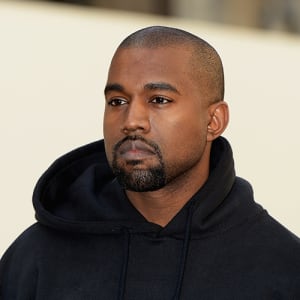 “The hosts of Fox & Friends argued on Sunday that Kanye West (pictured) could unite the country by running for president in 2020,” David Edwards reported Sunday for Raw Story. “During a segment on the Fox News morning show, host Jedidiah Bila noted that West had recently hinted on Twitter that he may be a candidate in 2020. ‘I think that expectation of unity can exist somewhere and should exist somewhere, but you also have to expect that you’re not going to agree on this stuff,’ Bila explained. ‘So it’s very, very challenging to find unity.’ . . .”
“The hosts of Fox & Friends argued on Sunday that Kanye West (pictured) could unite the country by running for president in 2020,” David Edwards reported Sunday for Raw Story. “During a segment on the Fox News morning show, host Jedidiah Bila noted that West had recently hinted on Twitter that he may be a candidate in 2020. ‘I think that expectation of unity can exist somewhere and should exist somewhere, but you also have to expect that you’re not going to agree on this stuff,’ Bila explained. ‘So it’s very, very challenging to find unity.’ . . .”
- “Telemundo’s digital expansion efforts have reached a significant milestone,“ Veronica Villafañe reported Thursday for Forbes. “The Spanish-language network has surpassed 10.6 million subscribers on its main Telemundo YouTube channel, passing the 10M mark July 1. It is the only U.S. television broadcast channel to have that many subscribers, regardless of language, according to YouTube June 2020 data. . . .”
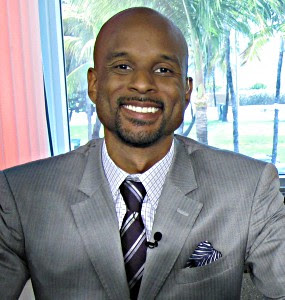 “ESPN has reached a multi-year contract extension with Bomani Jones (pictured) who will continue to host the ESPN Podcast, The Right Time with Bomani Jones, twice per week,” Radio Ink reported Thursday . “In May, Jones’ show was downloaded more than 650,000 times, a 60% increase over last year. . . .”
“ESPN has reached a multi-year contract extension with Bomani Jones (pictured) who will continue to host the ESPN Podcast, The Right Time with Bomani Jones, twice per week,” Radio Ink reported Thursday . “In May, Jones’ show was downloaded more than 650,000 times, a 60% increase over last year. . . .”
- Leaders of Native American organizations are protesting an op-ed column by Lloyd Omdahl, a former Democratic lieutenant governor of North Dakota, that ran in several of the state’s newspapers. “Mr. Omdahl’s call to action was wrong on the facts, and was rife with breathtakingly racist and offensive commentary,” they contended. Omdahl wrote, “The problem involves the Indian Child Welfare Act that requires that foster children be returned to the tribe even though white foster parents have provided them with education, medical care and love that would not be available on the reservation. . . .”
- “Reggae legend Ziggy Marley will receive the National Newspaper Publishers Association’s (NNPA) 2020 Global Icon Achievement Award during the NNPA’s Annual Convention scheduled for Wednesday, July 8, and Thursday, July 9,” Stacy Brown reported Thursday for NNPA, which represents publishers of Black newspapers.
- “CNN Brasil reporter Bruna Macedo was robbed at knifepoint during a live report in São Paolo on Saturday,” Charlie Nash reported for Mediaite. “During Macedo’s report on rising water levels at Bandeiras Bridge in São Paolo, a man could be seen on camera behind the reporter, watching, before he made his move and approached her. Though Macedo initially greeted the man, he quickly pulled out a knife, prompting Macedo to hand over two mobile phones, as CNN Brasil cut the feed. . . .”
- Cuban authorities should immediately release journalist Jorge Enrique Rodríguez and stop harassing the independent media, the Committee to Protect Journalists said Thursday. “On June 28, security forces arrested Rodríguez, of the independent news site Diario de Cuba, and took him to the criminal processing center known as Vivac in Havana, according to Mirta Fernández Laffitte, editor-in-chief of Diario de Cuba, who spoke with CPJ over the phone, and news reports. A trial is set for July 7. . . .”
- “Tanzanian authorities should immediately restore Tanzania Daima’s license and allow all newspapers to publish freely,” the Committee to Protect Journalists said June 26. “In a June 23 statement, Tanzania’s Information Services Department, which registers print media, announced it would revoke Tanzania Daima’s distribution and publication license as of June 24, according to news reports and a copy of the statement, which CPJ reviewed. The statement accused the publication of breaching the law and professional ethics, and banned its distribution domestically and abroad. . . .”
- “Venezuelan authorities should immediately drop all charges against journalists María Luisa ‘Mimi’ Arriaga and Marco Aurelio Antoima, and stop using the country’s anti-hate law to persecute the press, the Committee to Protect Journalists said June 25. “On June 18, agents from the Venezuelan judicial police raided Arriaga’s home in the El Hatillo neighborhood in Caracas and arrested her, according to reports from the local press freedom organizations Espacio Públic and the National Union of Press Workers. . . .”
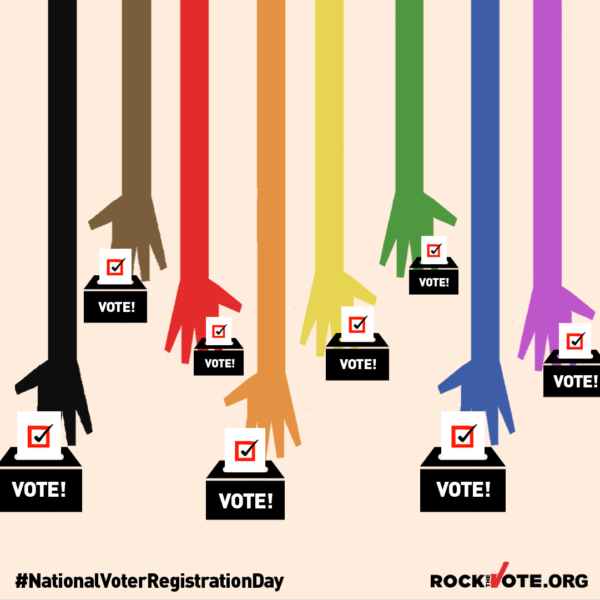
Rock the Vote, a nonpartisan organization that is working with businesses and influencers, has asked Journal-isms to help publicize its National Voter Registration Day, to take place Sept. 22.
Facebook users: “Like” “Richard Prince’s Journal-isms” on Facebook.
Follow Richard Prince on Twitter @princeeditor
Richard Prince’s Journal-isms originates from Washington. It began in print before most of us knew what the internet was, and it would like to be referred to as a “column.” Any views expressed in the column are those of the person or organization quoted and not those of any other entity. Send tips, comments and concerns to Richard Prince at journal-isms-owner@yahoogroups.com
View previous columns (after Feb. 13, 2016).
- Diversity’s Greatest Hits, 2018 (Jan. 4, 2019)
- Book Notes: Is Taking a Knee Really All That? (Dec. 20, 2018)
- Book Notes: Challenging ’45’ and Proudly Telling the Story (Dec. 18, 2018)
- Book Notes: Get Down With the Legends! (Dec. 11, 2018)
- Journalist Richard Prince w/Joe Madison (Sirius XM, April 18, 2018) (podcast)
- Richard Prince (journalist) (Wikipedia entry)
- February 2018 Podcast: Richard “Dick” Prince on the need for newsroom diversity (Gabriel Greschler, Student Press Law Center, Feb. 26, 2018)
- Diversity’s Greatest Hits, 2017 — Where Will They Take Us in the Year Ahead?
- Book Notes: Best Sellers, Uncovered Treasures, Overlooked History (Dec. 19, 2017)
- An advocate for diversity in the media is still pressing for representation, (Courtland Milloy, Washington Post, Nov. 28, 2017)
- Morgan Global Journalism Review: Journal-isms Journeys On (Aug. 31, 2017)
- Diversity’s Greatest Hits, 2016
- Book Notes: 16 Writers Dish About ‘Chelle,’ the First Lady
- Book Notes: From Coretta to Barack, and in Search of the Godfather
- Journal-isms’ Richard Prince Wants Your Ideas (FishbowlDC, Feb. 26, 2016)
- “JOURNAL-ISMS” IS LATEST TO BEAR BRUNT OF INDUSTRY’S ECONOMIC WOES (Feb. 19, 2016)
- Richard Prince with Charlayne Hunter-Gault,“PBS NewsHour,” “What stagnant diversity means for America’s newsrooms” (Dec. 15, 2015)
- Book Notes: Journalists Follow Their Passions
- Book Notes: Journalists Who Rocked Their World
- Book Notes: Hands Up! Read This!
- Book Notes: New Cosby Bio Looks Like a Best-Seller
- Journo-diversity advocate turns attention to Ezra Klein project (Erik Wemple, Washington Post, March 5, 2014)

